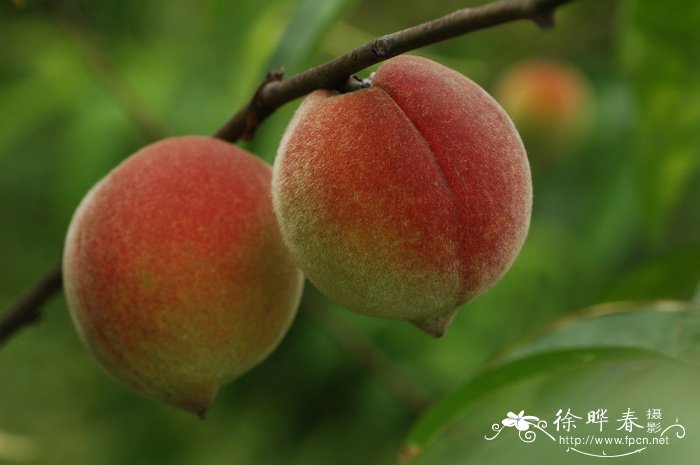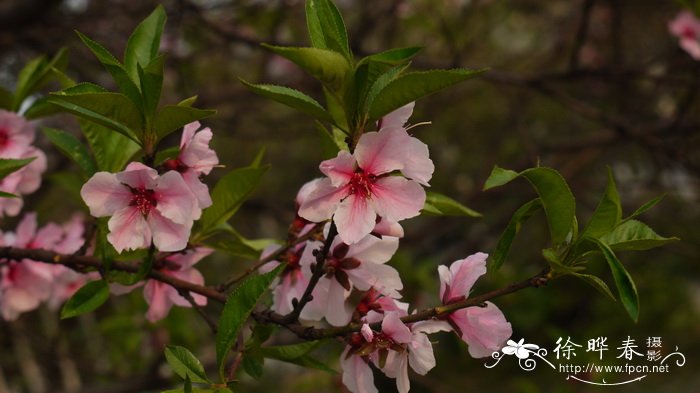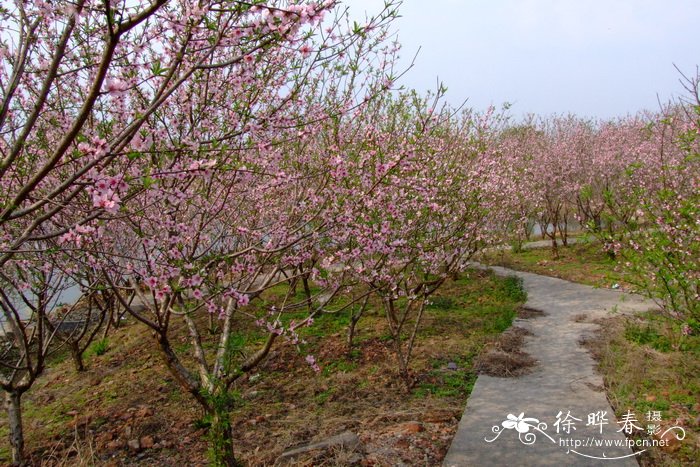桃Amygdalus persica
中文名(Chinese Name):桃
学名(Scientific Name):Amygdalus persica
英文名(English Common Name):peach
别名(Chinese Common Name):
异名(Synonym):
科属(Family & Genus):蔷薇科(Rosaceae)桃属
形态特征(Description):Amygdalus persica var. aganonucipersica (Schübler et Martens) Yü et Lu Amygdalus persica var. scleropersica (Reich.) Yü et Lu Amygdalus persica var. compressa (Loud.) Yü et Lu Persica vulgaris Mill. Persica vulgaris var. compressa Loudon Persica platycarpa Decne. Prunus persica var. platycarpa (Decne.) L. H. Bailey Prunus persica (L.) Batsch Prunus persica subsp. platycarpa (Decne.) D. Rivera et al. Prunus persica var. compressa (Loudon) Bean Prunus vulgaris Mill.
分布(Distribution):原产我国,各省区广泛栽培。世界各地均有栽植。
用途(Use):
引自中国植物志英文版:FOC Vol. 9 Page 394
Amygdalus persica Linnaeus, Sp. Pl. 1: 472. 1753.
桃 tao| Rosaceae | Amygdalus
Amygdalus persica [unranked] aganonucipersica Schübler & Martens; A. persica var. aganonucipersica (Schübler & Martens) T. T. Yü & L. T. Lu; A. persica [unranked] aganopersica Reichenbach; A. persica var. compressa (Loudon) T. T. Yü & L. T. Lu; A. persica [unranked] scleronucipersica Schübler & Martens; A. persica var. scleronucipersica (Schübler & Martens) T. T. Yü & L. T. Lu; A. persica [unranked] scleropersica Reichenbach; A. persica var. scleropersica (Reichenbach) T. T. Yü & L. T. Lu; Persica platycarpa Decaisne; P. vulgaris Miller; P. vulgaris var. compressa Loudon; Prunus persica (Linnaeus) Batsch; P. persica var. compressa (Loudon) Bean; P. persica subsp. platycarpa (Decaisne) D. Rivera et al.; P. persica var. platycarpa (Decaisne) L. H. Bailey.
Trees 3–8 m tall, with a broad and ± horizontally spreading crown. Bark dark reddish brown, scabrous and squamose with age. Branchlets green but reddish on exposed side, slender, glabrous, lustrous, with many small lenticels. Winter buds often 2 or 3 in a fascicle, conical, pubescent, apex obtuse. Petiole robust, 1–2 cm, with or without 1 to several nectaries; leaf blade oblong-lanceolate, elliptic-lanceolate, or obovate-oblanceolate, 7–15 × 2–3.5 cm, abaxially with or without a few hairs in vein axils, adaxially glabrous, base broadly cuneate, margin finely to coarsely serrate, apex acuminate. Flowers solitary, opening before leaves, 2–3.5 cm in diam. Pedicel very short to flower subsessile. Hypanthium green with a red tinge, shortly campanulate, 3–5 mm, outside pubescent or rarely subglabrous. Sepals ovate to oblong, ± as long as hypanthium, outside pubescent to rarely subglabrous, apex obtuse. Petals pink or white, oblong-elliptic to broadly obovate, 1–1.7 × 0.9–1.2 cm. Stamens 20–30; anthers purplish red. Ovary pubescent. Style nearly as long as stamens. Drupe color varies from greenish white to orangish yellow, usually with a red tinge on exposed side, ovoid, broadly ellipsoid, or compressed globose, (3–)5–7(–12) cm in diam. and usually nearly as long, densely pubescent, very rarely glabrous, ventral suture conspicuous; mesocarp white, greenish white, yellow, orangish yellow, or red, succulent, sweet to sour-sweet, fragrant; endocarp large, ellipsoid to suborbicular, compressed on both sides, surface longitudinally and transversely furrowed and pitted, free from mesocarp or compactly adnate to it, apex acuminate. Seed bitter, rarely sweet. Fl. Mar–Apr, fr. Aug–Sep.
Cultivated throughout China, escaped from cultivation in waste fields or on disturbed slopes; 1500--2200 m. Escaped from cultivation in at least Gansu, Hebei, and Shanxi.
Although native to N China, truly wild peaches no longer exist. Peaches are important, fruit-bearing and ornamental plants cultivated throughout temperate and subtropical zones. Cultivated varieties have been named for whether the fruit are compressed or not, whether the fruit surface is pubescent or glabrous, and whether the endocarp is free or adnate to the mesocarp.



(责任编辑:徐晔春)
学名(Scientific Name):Amygdalus persica
英文名(English Common Name):peach
别名(Chinese Common Name):
异名(Synonym):
科属(Family & Genus):蔷薇科(Rosaceae)桃属
形态特征(Description):Amygdalus persica var. aganonucipersica (Schübler et Martens) Yü et Lu Amygdalus persica var. scleropersica (Reich.) Yü et Lu Amygdalus persica var. compressa (Loud.) Yü et Lu Persica vulgaris Mill. Persica vulgaris var. compressa Loudon Persica platycarpa Decne. Prunus persica var. platycarpa (Decne.) L. H. Bailey Prunus persica (L.) Batsch Prunus persica subsp. platycarpa (Decne.) D. Rivera et al. Prunus persica var. compressa (Loudon) Bean Prunus vulgaris Mill.
分布(Distribution):原产我国,各省区广泛栽培。世界各地均有栽植。
用途(Use):
引自中国植物志英文版:FOC Vol. 9 Page 394
Amygdalus persica Linnaeus, Sp. Pl. 1: 472. 1753.
桃 tao| Rosaceae | Amygdalus
Amygdalus persica [unranked] aganonucipersica Schübler & Martens; A. persica var. aganonucipersica (Schübler & Martens) T. T. Yü & L. T. Lu; A. persica [unranked] aganopersica Reichenbach; A. persica var. compressa (Loudon) T. T. Yü & L. T. Lu; A. persica [unranked] scleronucipersica Schübler & Martens; A. persica var. scleronucipersica (Schübler & Martens) T. T. Yü & L. T. Lu; A. persica [unranked] scleropersica Reichenbach; A. persica var. scleropersica (Reichenbach) T. T. Yü & L. T. Lu; Persica platycarpa Decaisne; P. vulgaris Miller; P. vulgaris var. compressa Loudon; Prunus persica (Linnaeus) Batsch; P. persica var. compressa (Loudon) Bean; P. persica subsp. platycarpa (Decaisne) D. Rivera et al.; P. persica var. platycarpa (Decaisne) L. H. Bailey.
Trees 3–8 m tall, with a broad and ± horizontally spreading crown. Bark dark reddish brown, scabrous and squamose with age. Branchlets green but reddish on exposed side, slender, glabrous, lustrous, with many small lenticels. Winter buds often 2 or 3 in a fascicle, conical, pubescent, apex obtuse. Petiole robust, 1–2 cm, with or without 1 to several nectaries; leaf blade oblong-lanceolate, elliptic-lanceolate, or obovate-oblanceolate, 7–15 × 2–3.5 cm, abaxially with or without a few hairs in vein axils, adaxially glabrous, base broadly cuneate, margin finely to coarsely serrate, apex acuminate. Flowers solitary, opening before leaves, 2–3.5 cm in diam. Pedicel very short to flower subsessile. Hypanthium green with a red tinge, shortly campanulate, 3–5 mm, outside pubescent or rarely subglabrous. Sepals ovate to oblong, ± as long as hypanthium, outside pubescent to rarely subglabrous, apex obtuse. Petals pink or white, oblong-elliptic to broadly obovate, 1–1.7 × 0.9–1.2 cm. Stamens 20–30; anthers purplish red. Ovary pubescent. Style nearly as long as stamens. Drupe color varies from greenish white to orangish yellow, usually with a red tinge on exposed side, ovoid, broadly ellipsoid, or compressed globose, (3–)5–7(–12) cm in diam. and usually nearly as long, densely pubescent, very rarely glabrous, ventral suture conspicuous; mesocarp white, greenish white, yellow, orangish yellow, or red, succulent, sweet to sour-sweet, fragrant; endocarp large, ellipsoid to suborbicular, compressed on both sides, surface longitudinally and transversely furrowed and pitted, free from mesocarp or compactly adnate to it, apex acuminate. Seed bitter, rarely sweet. Fl. Mar–Apr, fr. Aug–Sep.
Cultivated throughout China, escaped from cultivation in waste fields or on disturbed slopes; 1500--2200 m. Escaped from cultivation in at least Gansu, Hebei, and Shanxi.
Although native to N China, truly wild peaches no longer exist. Peaches are important, fruit-bearing and ornamental plants cultivated throughout temperate and subtropical zones. Cultivated varieties have been named for whether the fruit are compressed or not, whether the fruit surface is pubescent or glabrous, and whether the endocarp is free or adnate to the mesocarp.
(责任编辑:徐晔春)
踩一下[14]

顶一下[29]